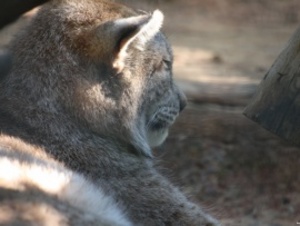The jaguar (Panthera onca) is the largest cat and the only extant member of the genus Panthera in the neotropics (Cat Specialist Group 2007). In the neotropics and in the rest of the world, humans disturb natural predator-prey relationships (Núñez et al. 2000), and cohabitation between humans and jaguars is often further strained by livestock depredation. The primary threat to these big cats is hunting by farmers in retaliation for depredation (Scognamillo 2003). Loss of preferred prey is another threat that often causes increased livestock depredation. Illegal hunting for sport, deforestation and habitat fragmentation pose further threats (Ojedca 1997). These felids are an important indicator species and top predators, often made scapegoats for poor livestock management and in need of protection rather than persecution from livestock ranchers in the neotropics. Many studies of jaguar spatial distribution and food habits offer hope for human-jaguar coexistence if some concessions are made by farmers and ranchers (Polisar et al. 2003).
The jaguar is a territorial carnivore that requires a large range to prowl. The ultimate determinant of territoriality is food abundance (de Azevedo and Murray 2007). Therefore, jaguars should be expected to maintain home ranges with relatively abundant prey. Forest composition, topographical characteristics, and the degree of habitat dispersal influence the distribution of prey species differently (Polisar et al. 2003). It follows that the jaguars studied inhabit mosaic landscapes (de Azevedo and Murray 2007, Núñez et al. 2000, Polisar et al. 2003). Since the value of a habitat patch is reduced by competition, overlap between individual jaguars and between jaguars and pumas (Puma concolor) will predict roaming habits within large ranges (Polisar et al. 2003). Average jaguar home range sizes are estimated between 85 km2 (de Azevado and Murray 2007) and 93km2 (Scognamillo et al. 2003). The large home range required poses a threat to their survival as human populations expand and land is lost to the jaguar.
Jaguar diet has been documented by analyzing scats and found kills (de Azevado and Murray 2007, Núñez et al. 2000, Polisar et al. 2003). Jaguars showed a preference for large-bodied prey (> 15kg), specifically caimen (Caimen yacare), capybara (Hydrochaeris hydrochaeris) and white-tailed deer (Odocoileus virginianus). In Mexico, Núñez et al. (2000) found white-tailed deer to be the most important wild prey species, making up 66% of the consumed biomass. In Brazil, de Azevado and Murray (2007) found capybara (24.3% of biomass consumed) and caimen (19.3% of biomass consumed) to be the most commonly killed wild prey. Scognamillo et al. (2003) determined collared peccaries (Tayassu tajacu) and capybara are taken most frequently in Venezuela, comprising 27% and 26% of wild prey biomass consumed respectively.
Predators select prey on the basis of costs and benefits as well as vulnerability factors (Polisar et al. 2003). Capybara are large, non-aggressive rodents which pose little threat to predators and have less flight capability than deer (Polisar et al. 2003). Caimen are less vulnerable in comparison to other prey due to their semi-aquatic behavior (Scognamillo et al. 2003). This explains why deer and caimen were taken less often than expected based on availability. This also explains why jaguars were shown to selectively prey upon capybara (Scognamillo et al. 2003).
Unfortunately, another demand of jaguar diet is livestock. Domestic animals comprised up to 38% of jaguar kills (Scognamillo et al. 2003), but these estimates may be exaggerated due to the higher detectability of livestock versus wild prey deaths (de Azevedo and Murray 2007). Livestock are often targeted because less effort is invested in the search, and cattle have fewer defenses than wild prey (Scognamillo et al. 2003). Polisar et al. (2003) outline eleven steps to facilitate coexistence of cattle ranches and jaguars. These include prevention of poaching of preferred prey and avoidance of commercial harvest of capybara (Polisar et al. 2003). In Venezuela, capybara management includes hunting by permit, as it is an important food source for rural inhabitants and is a major commercial product (Ojeda 1997).
The predatory activities of jaguars are important to the biodiversity of tropical forest systems (Núñez et al. 2000). Their presence is important in the top-down regulation of other species. For example, in the study site in Jalisco, Mexico, jaguars and pumas are estimated to remove up to 29% of the white-tailed deer in the reserve (Núñez et al. 2000). In the absence of these predators, deer numbers would increase. Overabundance of white-tailed deer is a problem in the United States. It has led to the decline of rodents and understory nesting birds, and to the devastation of understory vegetation and a decrease in canopy tree regeneration (Núñez et al. 2000). Consequentially, the presence of these felids both indicate and maintain a high level of ecosystem quality due to their status as a top predator (Núñez et al. 2000).
Jaguars are important to the ecosystems they inhabit, but are threatened as a consequence of human encroachment. Their effects on wild prey populations are essential to maintaining balance and biodiversity. Retaliation by cattle ranchers is a major cause of jaguar mortality, but if ranchers with knowledge of this big cat take a few simple steps to reduce their likelihood of conflict, humans can begin coexisting with this unique carnivore.
Literature Cited
de Azevedo, F. C. C., and D. L. Murray. 2007. Spatial organization and food habits of jaguars (Panthera
onca) in a floodplain forest. Biological Conservation 137(3):391-402.
Cat Specialist Group 2002. Panthera onca. In: IUCN 2007. 2007 IUCN Red List of Threatened
Species. . Downloaded on 28 October 2007.
Núñez, R., B. Miller, and F. Lindzey. 2000. Food habits of jaguars and pumas in Jalisco, Mexico.
Journal of Zoology 252(3): 373-379.
Ojeda, M. M. 1997. Wildlife Management in Venezuela: experiences and future perspectives. Wildlife Society Bulletin 25(1):49-56.
Polisar, J., I. Maxit, D. Scognamillo, L. Farrell, M.F. Sunquist, and J.F. Eisenberg. 2003. Jaguars, pumas, their prey base and cattle ranching: ecological interpretations of a management problem. Biological Conservation 109(3):297-310.
Scognamillo, D., I. E. Maxit, M. Sunquist, and J. Polsar. 2003. Coexistence of jaguar (Panthera onca) and
puma (Puma concolor) in a mosaic landscape in the Venezuelan llanos. Journal of Zoology 259(3):269-279.


